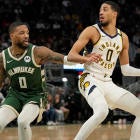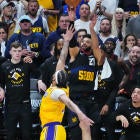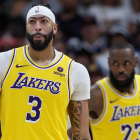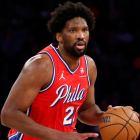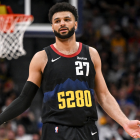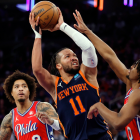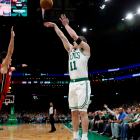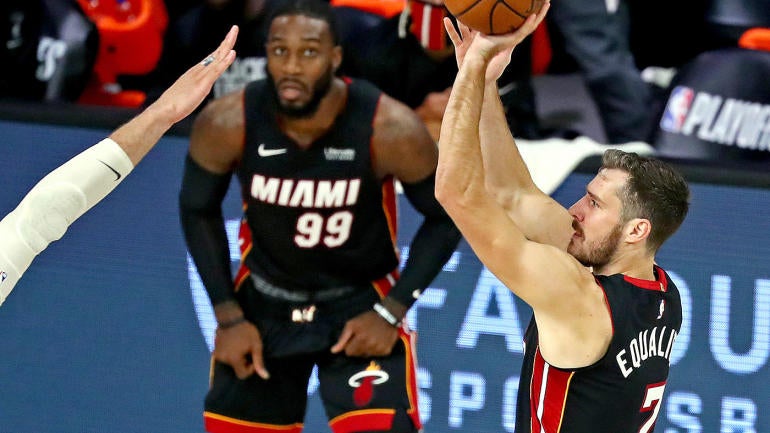
The Miami Heat are ahead of schedule. So dead set on preserving 2021 cap space were the Heat that a deadline deal for Danilo Gallinari collapsed, at least in part, over failed extension talks. The team prioritized its future over its present in letting an impact player slip away ... and then Miami made the NBA Finals anyway.
That fundamentally changes the expectations the Heat will face next season in potentially dangerous ways. The Heat were a No. 5 seed in the bubble. In a normal season, that would make them underdogs in the first round. Imagine what a catastrophe a first-round exit would be for Miami next season. The Heat could run back the same team and perform at the same level, but different circumstances could lead to inferior results, which in turn would create more difficult circumstances. Following up a Finals trip with one would be a colossal disappointment, one that the Heat would have to explain to 2021's best free agents.
That puts the Heat in a rather awkward position in devising their approach to the 2020 offseason. They are contenders, but nobody would reasonably consider them favorites. The same could be said of their planned pursuit of Giannis Antetokounmpo. Miami is in the hunt, but the Milwaukee Bucks appear to be leading the pack, and the Dallas Mavericks and Toronto Raptors will have similarly compelling pitches. A longer-range rebuild fits that same mold. In Bam Adebayo, Tyler Herro, Duncan Robinson and Kendrick Nunn, the Heat have one of the best young cores in basketball, but no MVP-caliber prospect to build around. The Heat, as currently constructed, are designed to be very good for a very long time, but don't stand out as a likely championship favorite at any single point in the perceivable future.
The Heat can use this offseason to tip the scales in one direction or another, or they can punt the choice away and trust their unmatched organizational excellence to strike when the opportunity better suits them. It is the blessing and the curse of exceeding expectations. For better or worse, all eyes are going to be on the Heat next season, and that starts with the decisions they make right now.
Below is our preview of the myriad paths the defending Eastern Conference champions can take this offseason. One note before beginning: We will be using Spotrac for player salaries, and 2019-20 cap numbers for this exercise as a whole. That includes previously agreed-upon numbers like the rookie scale and the minimum salary. A frozen cap is the likeliest outcome of negotiations between the league and the NBPA, but these numbers could theoretically change in either direction.
Under the assumption that the 2019-20 numbers will be used, these are the pertinent numbers for these projections.
Salary cap | $109,140,000 |
Luxury tax | $132,627,000 |
Luxury tax apron | $138,928,000 |
Salary floor | $98,226,000 |
Non-taxpayer mid-level exception (Year 1) | $9,258,000 |
Taxpayer mid-level exception (Year 1) | $5,718,000 |
Cap room mid-level exception (Year 1) | $4,767,000 |
Bi-annual exception | $3,623,000 |
Cap situation and overall finances
The Heat traded for Andre Iguodala in part to improve their 2020 roster, but also to maximize immediate flexibility. The deal shipped out Miami's two most onerous contracts: James Johnson and Dion Waiters. In their place came Jae Crowder and Solomon Hill on expiring deals. The pre-pandemic idea here was to get close enough to max cap space that it could be created if the Heat needed to.
Assuming Anthony Davis remains with the Lakers, the Heat won't need to create more cap space. In fact, assuming Kelly Olynyk opts into his deal, Miami's best-case cap space projection is far more modest -- only around $21 million, when you factor in the two minimum-salary incomplete roster charges they'd be saddled with. That space would leave them somewhat depleted. Take a gander at their cap table. You'll notice some rather important missing names.
$34,379,100 | |
$15,000,000 | |
Kelly Olynyk* | $13,198,244 |
$5,115,492 | |
$3,822,240 | |
Kendrick Nunn** | $1,663,861 |
Duncan Robinson** | $1,663,861 |
$1,517,981 | |
$1,517,981 | |
No. 20 pick | $2,582,160 |
Ryan Anderson (dead money) | $5,214,583 |
A.J. Hammons (dead money) | $350,087 |
Total | $86,025,590 |
*player option
**non-guaranteed
No Crowder. No Hill. No Derrick Jones Jr. No Meyers Leonard. And most importantly, no Goran Dragic. Retaining some or all of them is entirely within Miami's power. The Heat have full Bird Rights on all five, and can therefore offer each up to the max. But doing so would rob them of their cap space. This is the first fork in the road for the Heat. The question of retention vs. additions will be our truest window into Miami's priorities.
If the goal is strictly to be better next season, the Heat will probably try to retain their own free agents. The cap space plan would leave the Heat only that $21 million or so, the $4.7 million cap room mid-level exception and the minimum to complete their team. The combination of Dragic, Crowder, Jones, Leonard and Hill is worth far more than that. If Dragic maintains his playoff performance next season, there might not be a more impactful non-Davis unrestricted free agent on the entire market. The 2020-21 Heat would undoubtedly be better with all or most of those players back than, say, the addition of a Fred VanVleet or Jerami Grant in conjunction with the cap room mid-level exception.
However, there are two necessary caveats to the "bring the band back together" plan. The first is that, given the ages of most of those players and the uncertainty of the 2021 cap, the Heat would almost certainly only offer one-year deals. They could be hefty one-year deals, but Dragic is 34 and Crowder is 30. They might prefer the security of long-term arrangements. The Heat would love to have either back. They would not and should not sacrifice their shot at cap space for Giannis over sentimentality.
Also, only handing out one-year deals could create a serious cash strain on ownership. The Arison family isn't known for paying the tax. It infamously used the amnesty provision on Mike Miller against the wishes of LeBron James in 2013 just to avoid it. Their wealth is derived from Carnival Cruise Line. That's not a great business to be in during a pandemic. There is also the matter of the Heat's young players. Miami's cap space explodes after the 2021 offseason. Why? Because Bam Adebayo, Duncan Robinson and Kendrick Nunn are all owed new contracts next summer. It is exceedingly rare for a team to spend max cap space and pay the tax in the same season, but it is a near certainty for the 2021-22 Heat. They will be in the tax for quite some time afterward, assuming all goes well on the court. Avoiding the tax now is imperative on that front as it delays the clock on the repeater tax, which kicks in when a team has paid the tax in three consecutive seasons, or four out of five. That is especially important since the Heat just paid the tax last season. Avoiding it now buys them two seasons on the repeater clock.
With that in mind, the Heat are probably operating with an artificial hard cap. They aren't topping the $132,627,000 luxury tax line. That gives them roughly $46.6 million to work with in retaining their own free agents and reshaping the margin. Dragic and Crowder are both likely to get offers around the full MLE. That's more than $40 million over four years. How much do the Heat have to dangle to keep them off the market? Would $15 million apiece do the job? Something closer to the $20 million?
Crowder, at 30, would probably be more amenable. His skill set is universal. He'll get a big contract in 2021 no matter what. But Dragic just missed most of the Finals due to injury, and as well as he played in the playoffs, his regular-season value has undoubtedly declined. If he leaves an extra $20M-25M on the table now, he might not get it back in a year. He is such an instrumental part of Miami's culture that he might take the short deal regardless just to play for the team he knows (and can win with), but that's no certainty.
Depending on where those two come in, or if one leaves, the Heat could comfortably use at least part of the MLE while leaving minimum slots for their two final roster spots. Pat Riley's M.O. would be just to use that on the best possible player, but a better backup for Adebayo would probably make the most sense. The Heat were 6.5 points worse per 100 possessions with him on the bench in the playoffs, often resorting to Iguodala or Hill at center as a desperation measure, and for the sake of preserving his body, it probably makes sense to play him more at power forward during the regular season. In the bubble, he became a full-time center.
Tristan Thompson would be a wonderful fit as a switchy defender and pick-and-roll finisher. Dwight Howard has similar appeal. Unless he takes the minimum, this likely costs the Heat Leonard, but he is somewhat redundant with Olynyk in place anyway. Jones, sadly, is probably gone. The Heat just can't justify paying him what the open market will be given how few playoff minutes he just got. Some team is going to bet its mid-level exception on his upside. Unless Dragic or Crowder leave, Jones' return should be viewed as unlikely.
That's what's behind Door No. 1. Behind Door No. 2 is cap space, and it's infinitely more complicated. The incumbents might take one-year deals. Top free agents won't. The players that might make using cap space worthwhile are all going to demand, and gladly receive from several teams, multi-year offers. That means eating into 2021 cap space, which is problematic for the Heat because they have absolutely no idea how much breathing room they'll have.
Only three Heat players will have guaranteed contracts for 2021-22 entering next offseason: Butler, Okpala and this year's first-round pick. Herro will be guaranteed soon enough, but afterward, the Heat have to figure out what to do about their three big free agents. Adebayo is somewhat simple. He is eligible for a max extension right now, but he isn't going to get it. It's a common tactic used by teams planning for cap space. Adebayo's cap hold in restricted free agency will be only $15,346,476. His max salary would be almost twice that. He'll almost certainly get that contract, but he'll have to play out the 2020-21 season without the guarantee in the interest of preserving space. Kawhi Leonard went through that exact process in San Antonio. How'd that turn out? Nothing yet suggests Adebayo will be upset by that fact, but you never know.
The Heat can similarly depress the cap numbers of Nunn and Robinson, but it would be dicey. Both will be restricted free agents as well, but their cap holds will depend on whether or not they hit the "starter criteria" for a restricted free agent. To hit that criteria, those players need to start at least 41 games or play at least 2,000 minutes next season, or average those totals over last season and next season combined, though those numbers may be amended next season in light of the pandemic's impact on the schedule. The difference in their cap holds would amount to roughly $2.6 million, each. It won't cost either of them cash. They'll both get bigger offers than this in free agency, probably from the Heat after they've spent their cap space and can start signing their own players. But the Heat are faced with a fascinating dilemma here. They can create artificial cap space by playing Robinson and Nunn less. Are they willing to sacrifice possible 2021 wins for extra 2021 cap space? The answer is probably no, but it's worth watching.
Let's say the Heat have Adebayo on his low cap hold, but Robinson and Nunn on their highest ones. That's $74.5 million committed to seven players, which takes us to around $80 million spoken for with Incomplete Roster Charges included. If we pretend that the original 2020-21 projection of $115 million becomes the 2021-22 cap, they'd just barely have enough wiggle room to fit Giannis at his projected $34.5 million max as it is. They could create an extra $3.6 million or so by renouncing Nunn, but the truth is that they probably don't have much room to work with under this projection. If the pandemic is over and the cap rises to its originally projected $125 million level? Some extra 2020 spending might be feasible. The truth is that we just don't know where this will shake out, and if the Heat sign someone expensive now, they might have to turn around and trade that player after the season to create max space.
That suggests that the Heat will probably stick to one-year deals, but the player to watch out for on a longer-term contract would be Grant. Reports have already suggested that the Heat are interested, and he'd fit well within their amorphous defense. Something in the four-year, $60 million range is probably what it will take to get a deal done. Throw a bit more cash on the table and VanVleet becomes feasible, and he'd be a perfect fit as a secondary ball-handler and ace defender, but the truth is that Miami might not have enough cap space to outbid teams like the New York Knicks and Detroit Pistons, let alone Toronto with Bird Rights.
The Heat will explore all of these scenarios, and their cap people are smarter than all of us. If they see a path to adding a significant, long-term piece without taking themselves out of the Giannis sweepstakes, they'll take it. Just don't bank on that. It makes financial and basketball sense for them to act conservatively in free agency. Their cap flexibility is too important, and they have too many other ways to improve.
Draft capital
- 2020 picks: No. 20
- Owed future first-round picks: 2021 to Houston Rockets or Oklahoma City Thunder (OKC gets the two most favorable picks between themselves, Miami and Houston, while Houston gets the least favorable), 2023 to OKC (lottery protected in 2023, 2024 and 2025, unprotected in 2026).
- Incoming future first-round picks: N/A
Miami's draft pick situation might be even more complicated than its cap sheet. Technically, the Heat owe only two first-round picks to other teams. The way those picks are structured, though, leaves them without a single tradable first-round pick. That's the Stepien Rule at work. It prevents teams from being without a first-round pick in consecutive seasons. The Heat will have a first-round pick in three of the four years between 2023-2026 ... but because they won't have their pick in one of those seasons, the Stepien Rule treats them as if they won't a first-round pick in any of those seasons. Even their 2027 pick is unmovable right now because league rules act as if they don't have a 2026 pick.
There is a way around this if the need to trade a pick arises, but it's costly. The Heat and Thunder could agree to remove or alter the protections on that second pick in order to make a future pick tradable. They discussed this very idea when negotiating the failed Gallinari deal in February. Essentially, if the Heat converted that 2023 pick into an unprotected pick, there would be no chance of them owing a pick in 2024, 2025 or 2026, making either the 2025 and 2027 picks, or just the 2026 pick, available for trade. They would get no compensation for doing this, though. They would merely be surrendering a more valuable asset to the Thunder for the sake of facilitating another trade. They probably expect their 2023 pick to be fairly low with Adebayo presumably in his prime by that point, but there's always danger in sacrificing an unprotected pick. Imagine if the Golden State Warriors had given up their unprotected 2020 first-rounder years ago in an effort to add talent around Kevin Durant. Some other team would have the No. 2 pick right now.
Before the Heat even consider their future picks, there's the matter of their current No. 20 selection to think about. The Heat tend not to pick with need in mind. They took Adebayo with Hassan Whiteside seemingly entrenched at center, after all, and this roster isn't exactly full of holes. A defensive-minded guard and a backup center would be nice, but the Heat can afford to make a luxury pick.
Their history with Herro and Adebayo suggests that we should look to Kentucky first. Their lone first-round prospect happens to fill that need for a guard-sized stopper. Tyrese Maxey is a perfect theoretical backcourt partner for Herro as an excellent defensive prospect with the length to defend either guard spot. Upside prospects like Patrick Williams, R.J. Hampton and Aleksej Pokusevski could fit the bill here as well. Some time in Miami's development infrastructure could do wonders for any of them. Pokusevski and other European options make sense as cap propositions as well. The Heat probably wouldn't mind stashing their pick abroad and delaying the clock on their rookie deals. Ultimately, though, the Heat are opportunists in the draft. If someone falls, they will draft on talent. That's how they landed Justise Winslow in 2015. That story dovetails nicely into our next section. The Heat traded Winslow. They're willing to trade almost anybody. And if they want to get creative, there are going to be some interesting trade options on the board this offseason as well.
Trade options
The trade market comes with the same restrictions as free agency for the Heat. They're not paying the tax, and they probably aren't taking on long-term money. The difference lies in the players that are available. There are plenty of 2021 free agents that could help the Heat next season for a relatively low price, and they can aggregate $27.1 million in expiring salary through Olynyk and Iguodala, so those trading partners wouldn't need to eat long-term money. Two possible targets stand out for that sort of package.
- LaMarcus Aldridge is owed $24 million in the last year of his deal. He is also 35 years old on a team that is presumably rebuilding and just acquitted itself well in the bubble without him. The Heat pursued Aldridge in 2015 free agency. He would fit comfortably into the Olynyk/Leonard shooting big man role, and could provide some sorely-needed shot-making for the second unit, as the Heat scored only 102.7 points per 100 possessions without Butler in the game in the playoffs. The Spurs chased Iguodala in 2017, and Olynyk could provide similar shooting. They would probably require some draft capital, but the basic outline of a deal exists here.
- Gordon Hayward is owed $34.1 million on the final year of his max contract, but with extensions for Jaylen Brown and Jayson Tatum coming, he may not be back after that. The Celtics are deep in luxury tax territory, and with the repeater tax looming in their near future, the $7 million cash savings of this sort of deal make some sense. The Heat pursued Hayward in 2017, and Olynyk previously played in Boston, so there is familiarity on all sides here. The Celtics could move Hayward guilt-free knowing they'd be sending him to a Finals team. They probably aren't going this route, but if ownership views the tax as particularly onerous, it's a conceivable path that gets them some depth and the Heat some extra offensive firepower. Their medical staff could have more success with him than Boston's has.
This is also Miami we're talking about. If there are true superstars on the trade market, the Heat are going to ask. The truth, though, is that most of them don't really make sense at the moment.
- Bradley Beal doesn't appear to be available. Even if he is, why would the Heat take on his salary before meeting with Giannis? Especially given the possibly obscene asset cost of such a trade?
- Jrue Holiday has a player option for next season and a lengthy history of injuries. The Heat aren't risking watching him opt in.
- There just isn't a good reason to trade for Victor Oladipo now. If he wants to join the Heat as badly as some reports claim, he can do so next offseason. There are sign-and-trade scenarios in which the Heat could feasibly acquire both Oladipo and Antetokounmpo, but the question is, why would they do it? Oladipo is a major health risk. The role players they'd have to give up to make that happen, like Herro and Robinson, are younger, cheaper and superior fits alongside those stars. More importantly, the Heat can reasonably expect them to be healthy next season. Unless the Heat genuinely believe Oladipo could win them the 2021 championship, trading for him now with the cloud of his leg injury hanging over a possible deal just doesn't make sense unless they are essentially giving up no asset value to do so. The Pacers aren't giving him away, so there isn't a deal here.
Few teams are more aggressive than the Heat. They're asking for players we haven't even thought of. But if there's a big trade to be had this summer, those first two names are probably the ones to watch, with a heavy emphasis on Aldridge.
What would an ideal offseason look like?
As we discussed all the way back in the introduction, the Heat made the NBA Finals ahead of schedule this past season. The question that raises is whether that single result, devoid of context, should be enough to convince the Heat to deviate from the plan they accidentally fast-tracked last season and really go for the championship right now. Most Finals losers are aggressive in seeking out immediate improvement, but most Finals teams get there under very different circumstances.
The Heat weren't a season-long juggernaut. They were a No. 5 seed playing in a once-in-a-lifetime bubble. They faced three teams dealing with varying degrees of injuries, none of whom had the home-court advantage a typical season would have afforded them. They got past those teams, but didn't have to face the sleeping giant in Brooklyn. Kevin Durant will be back next season. Most of the contenders Miami just beat are far more desperate to improve next season than the Heat are.
If the Heat are being totally honest with themselves, they can probably recognize that making the 2020 NBA Finals does not make them the best team in the Eastern Conference next season. Maybe an aggressive offseason could get them there, but the truth is that much of their playoff fortune is probably out of their hands. If Durant and Kyrie Irving are both at full strength and the Nets add a third star, is there anything the Heat could really do? Probably not. Miami shouldn't rule out a return to the Finals. Maybe what happened in the bubble is sustainable. Maybe the bracket breaks right for them. But it's not something the Heat should rely on because it's not something they need to rely on. Their best chance at a championship is probably coming beyond 2021 free agency. With or without Giannis, their current core combined with max cap space is going to yield a contender. That is the time to go all in. The goal for now is to maintain some semblance of their bubble momentum, and perhaps building on it in cheaper ways.
An Aldridge trade is probably the best way to do that. Unprotecting the 2023 pick in order to create a tradable pick for this deal would be a bitter pill to swallow, but the Heat should feel relatively confident in their ability to contend that far into the future. Let's say the Heat swap Olynyk, Iguodala and a protected 2025 pick to the Spurs for their star big man. The other advantage of that trade? It saves the Heat around $3 million.
That's more money to throw at Dragic and Crowder, who should be retained at any reasonable one-year cost. If that means giving each $20 million for the season, then so be it, though ideally, the cost would come in a bit cheaper than that. Even if that's what it takes, the Aldridge savings would give the Heat around $9 million to work with below the tax. That's enough to throw a decent chunk of the mid-level exception at a more defensive-minded big man on a one-year deal (with Thompson being the first choice and Howard being the backup and Nerlens Noel being a worst-case scenario).
That leaves two minimum slots. Hill coming back for one year would be ideal, but the Heat can afford to be picky. Better free agents will miss out on paydays in this cash-strapped environment, and they can offer a perfect one-year refuge. On that same note, don't be surprised if the Heat carry only 14 players on their opening night roster. That would give them some extra wiggle room to use some of the MLE, save a roster spot and some cash for a buyout market addition (in what should be a robust class after the deadline). They could rely on their two-way players as emergency fill-ins, stacking their 45 days with the NBA roster earlier in the season. The Heat once found Robinson as a two-way player. Odds are, whoever they fill those slots with this season is good for at least some spot duty.
This is the "best of both worlds" path, the one that theoretically gives the Miami Heat a better roster than they just had without sacrificing any meaningful element of their future. They may have jumped ahead of their plan by making the 2020 Finals, but the Heat's best chance at making it back there in the future is sticking to it this offseason.














